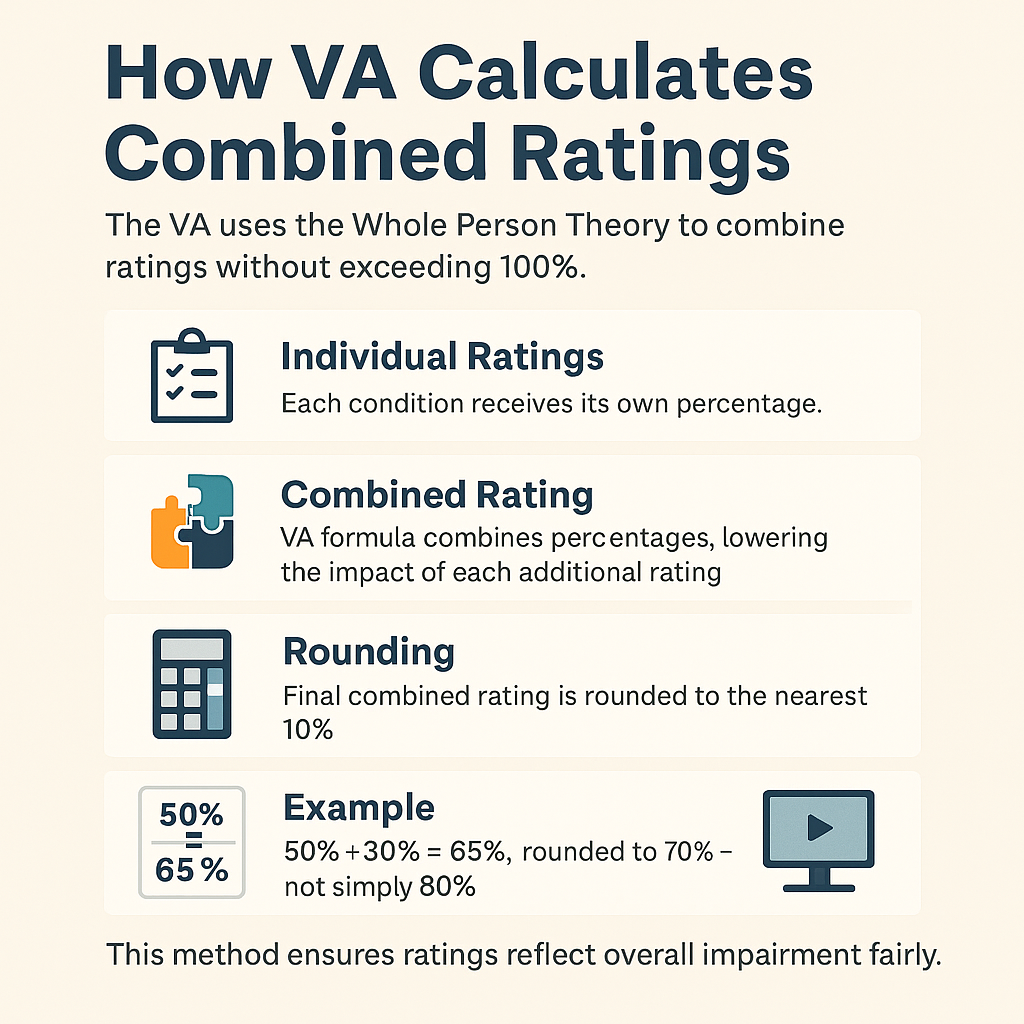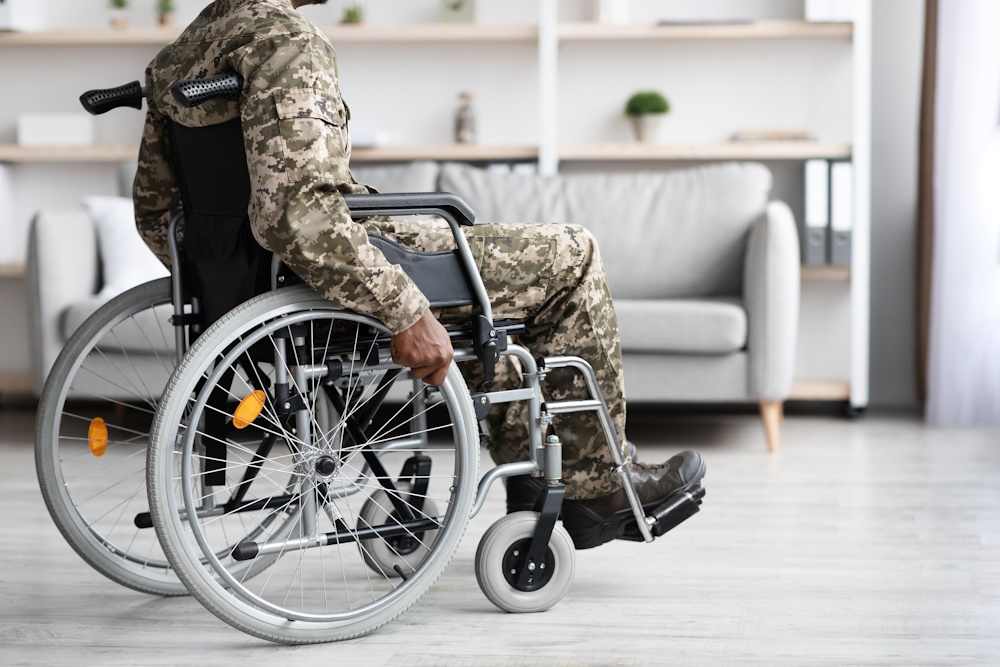The VA uses a rating system ranging from 0% to 100% in increments of 10% to assess the severity of each service-connected disability. The rate each veteran receives determines the monthly VA disability compensation they receive.
The rating also gives access to VA healthcare, vocational rehabilitation, and education support, in addition to the money.
Eligibility criteria for VA disability compensation are based on the severity and service connection of the disability. To reach a 70% disability rating, veterans typically have multiple service-connected conditions rated at varying levels of severity.

The VA uses a combined rating system, known as the ‘Whole Person Theory,’ to determine the overall disability rating for veterans with multiple conditions, rather than simply adding individual ratings together.
Monthly Payments
As of 2025, a veteran with a 70% disability rating and no dependents receives $1,759.19 per month, but the monthly compensation varies based on marital status and number of dependents.
Healthcare Benefits You Can Get
Veterans who have a 70% VA disability rating can get full VA health care. Veterans rated at 70% are placed in the highest priority group for VA health care (Priority Group 1), which includes full, no-cost services such as preventive care, mental health care, and prescription medications.

Opportunities for Education and Work
If you have a VA disability rating of 70%, it can make it easier to get help with school and work. You might be able to get Chapter 35 Dependents’ Educational Assistance, which helps family members go to school. Veterans are also able to get help with vocational rehabilitation programs to learn new skills for jobs that suit their abilities.
These chances can change your life by giving you a way to move forward when regular jobs seem out of reach.
Ways to Get a 100% Disability Rating
To increase a VA disability rating from 70% to a higher percentage, disabled veterans must demonstrate that their service-connected disabilities have worsened or that new disabilities have developed. You’ll need comprehensive documentation of their medical history and conditions as evidence supporting their disability claim.
Some veterans who are unable to work due to their disability can get 100% compensation through TDIU. To qualify for increased disability compensation under TDIU, veterans must show they are unable to maintain substantial employment because of their disabilities.
The good news is that you don’t need to have new medical conditions, just proof that your current conditions are making it difficult to keep a steady job.
If your claim for an increased disability rating is denied, you can appeal by providing additional evidence or requesting a new examination. Going for a higher rating can give you more benefits and long-term security.
FAQs About the 70% Rating
- What does it mean to have a 70% VA disability rating? It doesn’t mean completely disabled, but it does mean a majorly disabling condition (or conditions). Veterans at this level often have trouble with PTSD, severe depression, chronic pain, panic attacks, or other mental health issues such as post traumatic stress disorder. The rating is based on how much these conditions make it hard for people to do normal things. It opens the door to big health and financial benefits.
- How much money do veterans get each month at 70%? Veterans with a 70% VA disability rating will get $1,759.19 a month, tax-free, as of 2025. There are extra amounts for dependents like spouses, children, or parents.
- What health care benefits are included at 70%? Veterans with a 70% VA disability rating or higher can get VA healthcare first. This includes full medical coverage, mental health services, and prescriptions for little or no cost. You can also get specialized care for conditions that are related to your service.
- Is it possible for a veteran to go from 70% to 100% disability? Yes, veterans can get a higher rating through Total Disability based on Individual Unemployability (TDIU). If service-connected conditions make it hard for veterans to keep a job, TDIU lets them get 100% of their pay without new medical conditions. Veterans with multiple conditions can qualify for TDIU if they have a combined rating of 70% or higher, with at least one condition rated at 40% or more. Veterans must furnish evidence demonstrating that their disabilities preclude gainful employment.
- How does the VA calculate my disability rating? The VA uses a combined value approach to calculate your total disability percentage. Instead of simply adding individual ratings together, the VA combines them by identifying the lowest percentage at each step, which results in a final combined disability rating. This method ensures the overall rating accurately reflects the severity of your service-connected conditions.
- What evidence should I submit when applying or appealing? When applying for or appealing a VA disability claim, it is important to submit medical records, including both VA and private records, to support your case. Buddy statements from friends, family, or fellow service members can also help corroborate your symptoms and strengthen your claim, especially for mental health conditions.
- How can I estimate my VA disability benefits? Veterans can use a VA disability calculator to estimate their monthly compensation and understand how their ratings combine. This online tool helps simplify the process of calculating disability benefits and provides a quick way to see potential pay rates.
- What additional benefits are available with a 70% rating? Veterans with a 70% VA disability rating may be eligible for additional benefits such as state-specific programs (property tax exemptions, free driver’s licenses, reduced vehicle registration fees), a clothing allowance for items damaged by service-connected conditions, the Family Caregiver Program (which offers a stipend and support for caregivers), funding for home improvements through the Specially Adapted Housing (SAH) grant, travel pay for VA appointments, burial and plot allowance to help with funeral costs, and commissary and exchange privileges to shop at military stores.
- How do dependents and additional benefits affect my disability benefits? Having dependents can increase your monthly disability benefits. If you have multiple conditions, your combined rating may be higher, which can also impact the total disability benefits you receive. Additional benefits may be available based on your circumstances, so it’s important to review all options.

Giving Veterans Power Through Knowledge
The 70% VA disability rating is more than just a number. It’s a way to honor sacrifice and get important help. At this level, veterans get help with money, health care, and chances to learn and grow in their careers. Veterans can better advocate for themselves and find ways to get even more benefits if they understand the rating. Knowledge is power, and in this case, it can help you find resources that can change your life. Veterans can make sure they get all the help they need by learning how the system works.
 Benefits.com Advisors
Benefits.com Advisors
With expertise spanning local, state, and federal benefit programs, our team is dedicated to guiding individuals towards the perfect program tailored to their unique circumstances.
Rise to the top with Peak Benefits!
Join our Peak Benefits Newsletter for the latest news, resources, and offers on all things government benefits.


















